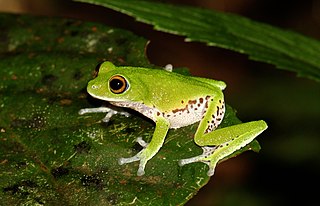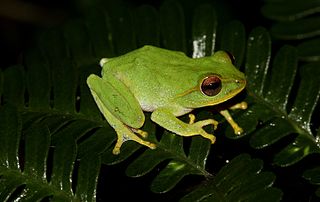
Pseudophilautus decoris, commonly known as the elegant shrub frog, is a species of frogs in the family Rhacophoridae. It is endemic to Sri Lanka.

Pseudophilautus hypomelas is a species of frog in the family Rhacophoridae endemic to Sri Lanka. It is sometimes referred to as the webless shrub frog. In 2004 it was declared extinct by the International Union for Conservation of Nature when, despite extensive field efforts, no specimen had been seen in the wild after the species was described by Albert Günther in 1876. However, this frog was rediscovered in 2010 in the Peak Wilderness, a highly biodiverse area in the Central Highlands of Sri Lanka. Thus, this species had been "lost" for more than 130 years.
Pseudophilautus mittermeieri, commonly known as Mittermeier's shrub frog, is a species of frog in the family Rhacophoridae. It is endemic to Sri Lanka.

Pseudophilautus mooreorum, commonly known as Moore's shrub frog, is a species of frog in the family Rhacophoridae. It is endemic to Sri Lanka.

Pseudophilautus poppiae, also known as Poppy's shrub frog, is a species of frog in the family Rhacophoridae. It is endemic to Sri Lanka. Its natural habitat is subtropical or tropical moist montane forests.Scientists have seen it between 1060 and 1270 meters above sea level.

Pseudophilautus rus, known as Kandian shrub frog is a species of frog in the family Rhacophoridae.
Pseudophilautus stellatus, also known as starry shrub frog or Kelaart's starry shrub frog, is a frog species in the family Rhacophoridae. It is endemic to Sri Lanka. It was thought to be extinct for 156 years until it was rediscovered in 2009 from the Peak Wilderness, Central Hills of Sri Lanka. This species was previously only known by the lost holotype which was described by Edward Frederick Kelaart in 1853. In 2013, a neotype was designated.

Pseudophilautus stuarti, known as Stuart's shrub frog, is a species of frogs in the family Rhacophoridae. It is endemic to Sri Lanka. It was first formally observed in Corbett's Gap in the Knuckles Mountain Range, 1249 meters above sea level.

Pseudophilautus zorro, the Gannoruwa shrub frog is a species of frogs in the family Rhacophoridae. It is endemic to central Sri Lanka. People have seen it near Kandy and in the Knuckles Forest Reserve, 500-800 meters above sea level.

Pseudophilautus is a genus of shrub frogs in the family Rhacophoridae endemic to the Western Ghats of southwestern India and to Sri Lanka where the majority of the species are found. Many of them are already extinct. On the other, some species believed to be extinct have also been rediscovered.
Pseudophilautus bambaradeniyai is a species of frogs in the family Rhacophoridae, endemic to Sri Lanka. Scientists know it from the type locality: Sripada Peak, Peak Wilderness, between 700 and 1400 meters above sea level.
Pseudophilautus dayawansai is a species of frog in the family Rhacophoridae, endemic to Sri Lanka.
Pseudophilautus hankeni, or Hanken's shrub frog, is a species of frog in the family Rhacophoridae, endemic to the Knuckles Mountain Range, Sri Lanka. It has been observed at altitutes of 1200 meters over sea level and higher.
Pseudophilautus jagathgunawardanai is a species of frogs in the family Rhacophoridae, endemic to Sri Lanka.
Pseudophilautus karunarathnai is a species of frogs in the family Rhacophoridae, endemic to Sri Lanka.
Pseudophilautus newtonjayawardanei is a species of frogs in the family Rhacophoridae, endemic to Sri Lanka.

Pseudophilautus puranappu is a species of frogs in the family Rhacophoridae, endemic to Sri Lanka. Scientists have know it from the type locality: Sripada Peak in the Peak Wilderness, between 1800 and 2100 meters above sea level.
Pseudophilautus samarakoon, the Samarakoon's shrub frog, is a species of frogs in the family Rhacophoridae, endemic to Sri Lanka. Wickramasinghe et al. suggest that, following the IUCN Red List criteria, it should be considered "critically endangered" because the extent of occurrence is <100 km2, it is recorded from a single location, and its habitat is under severe threat.

Pseudophilautus dilmah, the Dilmah shrub frog, is a species of frogs in the family Rhacophoridae, endemic to Sri Lanka. The species was discovered and documented in 2015 by Sri Lankan prominent wildlife researcher and herpetologist Mendis Wickramasinghe and his crew from Loolkandura forest of Central highlands of Sri Lanka. It is distinguished mainly from other shrub frogs by the absence of nuptial pads and anterior and posterior dorsum without horny spinules.

L. J. Mendis Wickramasinghe is a Sri Lankan herpetologist, taxonomist, naturalist,wildlife photographer. Inspired by a childhood passion on snakes and by the diversity of his motherland, he has spent over two decades experiencing the forests across Sri Lanka.










